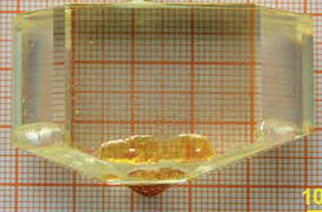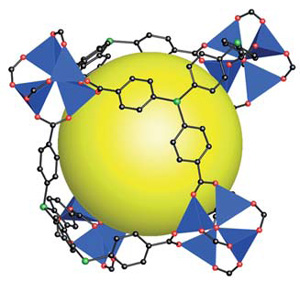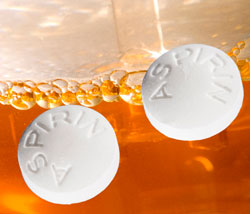 Vaterite is one of the three crystalline polymorphs of calcium carbonate, and plays a significant role in biomineralisation, either as an intermediate formed from amorphous calcium carbonate prior to transformation to aragonite or calcite, or can be utilized by organisms in its own right.
Vaterite is one of the three crystalline polymorphs of calcium carbonate, and plays a significant role in biomineralisation, either as an intermediate formed from amorphous calcium carbonate prior to transformation to aragonite or calcite, or can be utilized by organisms in its own right.
Recently there have been several key advances in our understanding the formation of calcium carbonate, and owing to its great importance not only in biomineralization the lack of a proper understanding of the solid-state structure of vaterite is certainly a considerable deficit. Despite its significance, there has been considerable debate regarding the nature of the structure of this material. While vaterite is known to exhibit disorder, several ordered structures are used as models to understand its crystal chemistry. In this HOT Article, Demichelis et al. have used ab initio calculations to show that the two most widely used structural models are actually transition states, rather than being stable, and that the third proposed literature model is too high in energy to be viable. Several new distorted structures for vaterite are proposed that are very close in energy and able to interchange, thereby creating a mechanism to explain the observed disorder. The final nature of the disorder may ultimately depend on the kinetics of the transformation from a precursor phase, as postulated for the ikaite to vaterite conversion.
Read more for FREE until the 22nd November at:
A new structural model for disorder in vaterite from first-principles calculations
Raffaella Demichelis, Paolo Raiteri, Julian D. Gale and Roberto Dovesi
CrystEngComm, 2011, Advance Article












 Vaterite is one of the three crystalline polymorphs of calcium carbonate, and plays a significant role in biomineralisation, either as an intermediate formed from amorphous calcium carbonate prior to transformation to aragonite or calcite, or can be utilized by organisms in its own right.
Vaterite is one of the three crystalline polymorphs of calcium carbonate, and plays a significant role in biomineralisation, either as an intermediate formed from amorphous calcium carbonate prior to transformation to aragonite or calcite, or can be utilized by organisms in its own right.


 In this HOT Article, two new phenyl-bridged pseudopeptidic ligands have been prepared and structurally characterised. The nature of the ligands’ substituents play an important role in the nature of the solid state structure yielding either hydrogen bonded linked sheets of molecules or infinite hydrogen bonded networks. To investigate this further, these ligands were reacted with a range of zinc(II) salts with the aim of synthesising coordination polymers and networks; the role of anions in determining the final structure was explored.
In this HOT Article, two new phenyl-bridged pseudopeptidic ligands have been prepared and structurally characterised. The nature of the ligands’ substituents play an important role in the nature of the solid state structure yielding either hydrogen bonded linked sheets of molecules or infinite hydrogen bonded networks. To investigate this further, these ligands were reacted with a range of zinc(II) salts with the aim of synthesising coordination polymers and networks; the role of anions in determining the final structure was explored. This HOT Article, describes the structural analysis of four new compounds and of known structures of related compounds revealing preferred
This HOT Article, describes the structural analysis of four new compounds and of known structures of related compounds revealing preferred In this HOT article, Chinese researchers report the synthesis and properties of spherical assemblies of NaYF4 nanocrystals via a facile solution-based method. Their novelty lies in the unique structural geometry of the NaYF4 assemblies attached together along one specific crystalline orientation. The impact of organic additives such as citric acid and polyvinylpyrrolidone on the crystal growth was investigated in detail and a possible formation mechanism is also proposed. This interesting hierarchical structure not only offers a high surface area and easy modification surface, but also provides a new efficient host for doping various lanthanide ions to give strong down- or up-conversion emissions. It is anticipated that these unique assembled NaYF4 nanostructures will serve as biolabels in various biomedical applications.
In this HOT article, Chinese researchers report the synthesis and properties of spherical assemblies of NaYF4 nanocrystals via a facile solution-based method. Their novelty lies in the unique structural geometry of the NaYF4 assemblies attached together along one specific crystalline orientation. The impact of organic additives such as citric acid and polyvinylpyrrolidone on the crystal growth was investigated in detail and a possible formation mechanism is also proposed. This interesting hierarchical structure not only offers a high surface area and easy modification surface, but also provides a new efficient host for doping various lanthanide ions to give strong down- or up-conversion emissions. It is anticipated that these unique assembled NaYF4 nanostructures will serve as biolabels in various biomedical applications. In this HOT article, Chinese researchers have demonstrated for the first time that ternary cation-alloyed PbSnS nanocrystals could be synthesized via a facile solution-based routine. The mean diameters of the as-prepared nanocrystals ranged from 6–15 nm. Several interesting variations on the crystal structure and band gap energy were indicated. The results could potentially have a high impact on IV-VI quantum dots based optoelectronic applications in the future.
In this HOT article, Chinese researchers have demonstrated for the first time that ternary cation-alloyed PbSnS nanocrystals could be synthesized via a facile solution-based routine. The mean diameters of the as-prepared nanocrystals ranged from 6–15 nm. Several interesting variations on the crystal structure and band gap energy were indicated. The results could potentially have a high impact on IV-VI quantum dots based optoelectronic applications in the future. In this CrystEngComm Hot article William Ducker from the University of Melbourne studies the mechanism for hydrothermal growth of ZnO, in collaboration with Virginia Polytechnic Institute and State University.
In this CrystEngComm Hot article William Ducker from the University of Melbourne studies the mechanism for hydrothermal growth of ZnO, in collaboration with Virginia Polytechnic Institute and State University.